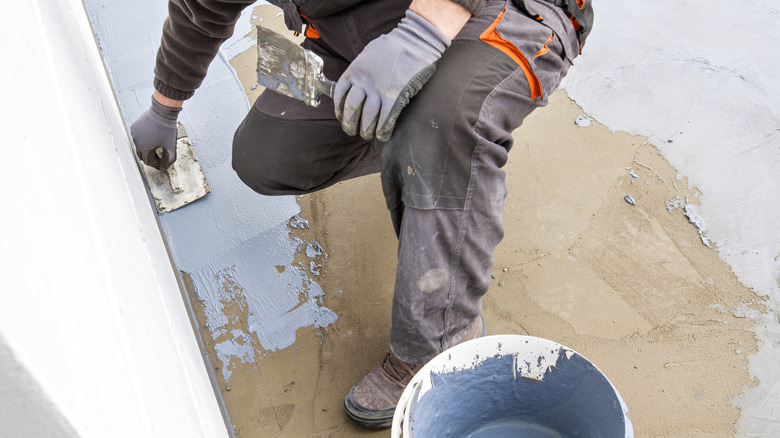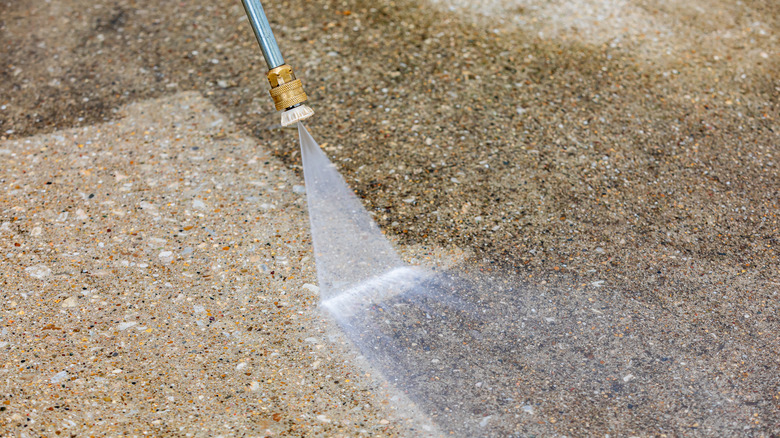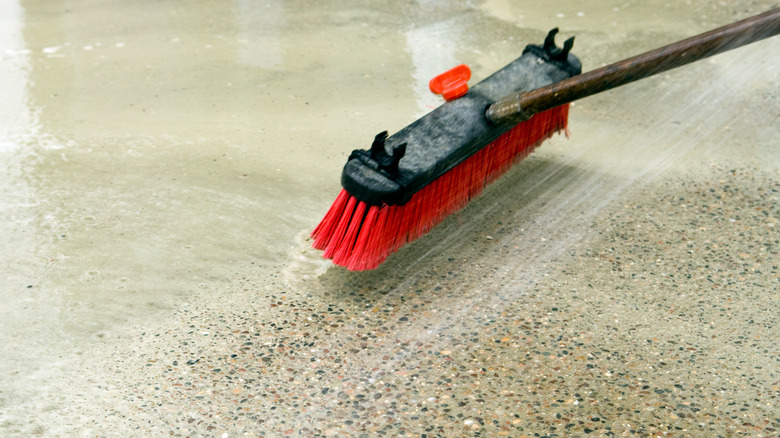The Technique You Should Learn If You Want To Upgrade Your Concrete Floor
If you're a homeowner, chances are that there's a concrete floor somewhere in the house, may it be in the garage, the basement, or the grade-level rec room. And unless you're into the industrial look, you probably don't want to leave the concrete bare. Whether it's sealant on your garage floor, or carpet adhered to the basement slab-on-grade, it's good to have that concrete covered for both practical and aesthetic reasons. But before you go upgrading the concrete slab, know this — if its surface is already smooth, any finish you apply may not penetrate it deeply enough. To ensure that the finish bonds well with the concrete, you should use a technique called "etching" before putting on a finishing compound like sealant or paint.
Etching is a process that makes concrete more porous, and it's usually done by applying a coating of acid to the concrete. The acid, urged on by the strokes of a push broom, chafes the concrete and prepares it for whatever finishing upgrade you have in mind. Doing so allows various finishing coatings to adhere to its surface better. If you're dealing with a smooth indoor slab, it's almost guaranteed that you'll have to etch its surface before treating it with sealant or paint. On the other hand, outdoor concrete surfaces should receive a finish without issues since they're porous enough already — unless they've been sealed in the past.
How to get ready to etch a concrete surface
The first thing you need to do is give the concrete a deep, thorough cleaning. Any stains, grease, bits of dirt, or any other substance that wound up on the slab since the time it was poured should be gone before you etch. The looser debris should come off easily with manual cleaning if you're using a quality brush and a concrete cleaner like this one from Lowe's. That said, you may run into trouble with older stains or stubborn bits of sealant. These are unlikely to come off with brushing because they've penetrated the concrete surface. To rid the concrete of these impurities, you'll need to grind or sand down the face of the concrete.
Now that the concrete floor is ready to go, it's time to prepare the etching mixture. How you do this will depend on the type of etching compound you're using. Phosphoric, muriatic, and sulfuric acids are all effective options. Regardless of which one you pick, be sure to strictly adhere to the instructions on the product's label and wear the safety equipment recommended by the manufacturer. Mishandling etching acid can cause severe reactions that burn your skin and produce highly toxic vapors. Likewise, discarding the etching solution improperly can damage nearby ecosystems and get you in trouble with the law. You may need authorization from local environmental authorities or the EPA before releasing the used etching acid into the wastewater.
How to apply the etching solution to a concrete floor
The acid manufacturer should specify the steps for etching, so be sure to read the label to get this part right. That said, the technique generally goes like this. Before applying the acid, moisten the concrete slab by either spraying it with a hose or using a watering can. Crucially, you must make the entire area evenly damp and keep it damp while etching. If the floor surface isn't small enough to treat at the same time, moisten and etch sections of it at a time.
With the concrete evenly wet, use a watering can to apply the acid solution. Make sure that the mix goes on evenly, without pooling in some areas and forgoing others. The manufacturer should specify how much solution is required per square foot of concrete — stick to this ratio for the best results. When you pour the acid on the floor, be careful not to cause splashes — you don't want acid landing on unprotected areas of your skin or clothing. Once the solution is applied, brush it into the surface using a push broom, and let it go to work on the concrete.
After 15 minutes, you can neutralize the acid with a mixture of baking soda and water, which also needs 10 minutes to work. Finally, rinse the slab with water and dispose of the mix according to local environmental regulations. Note that the concrete should be completely dry before you apply sealant or paint.


